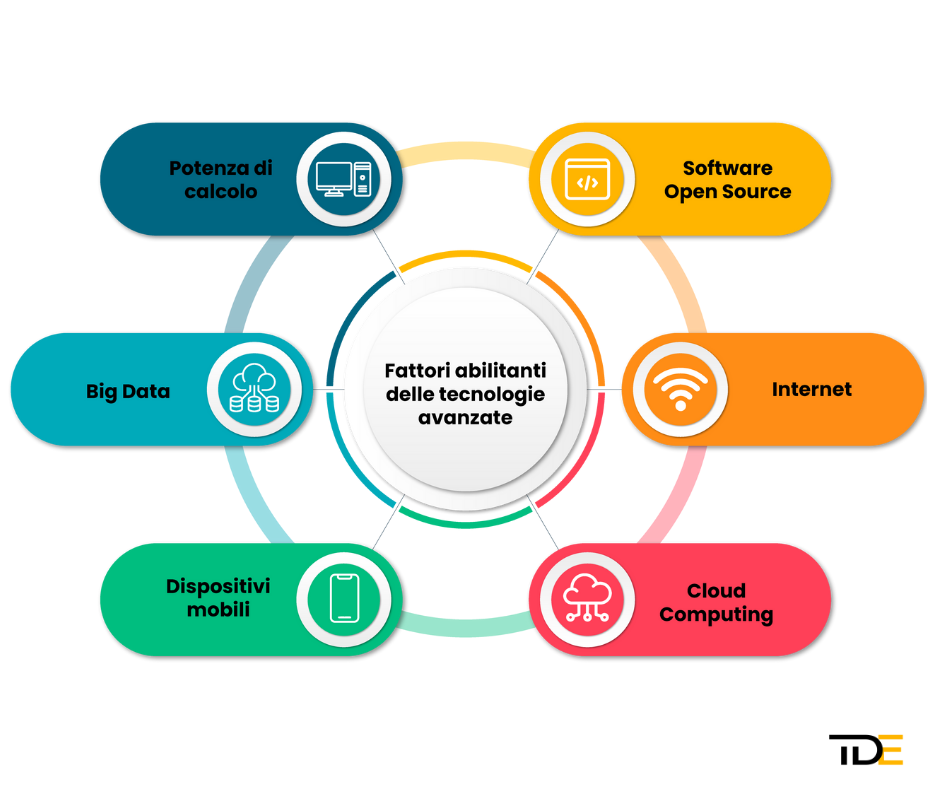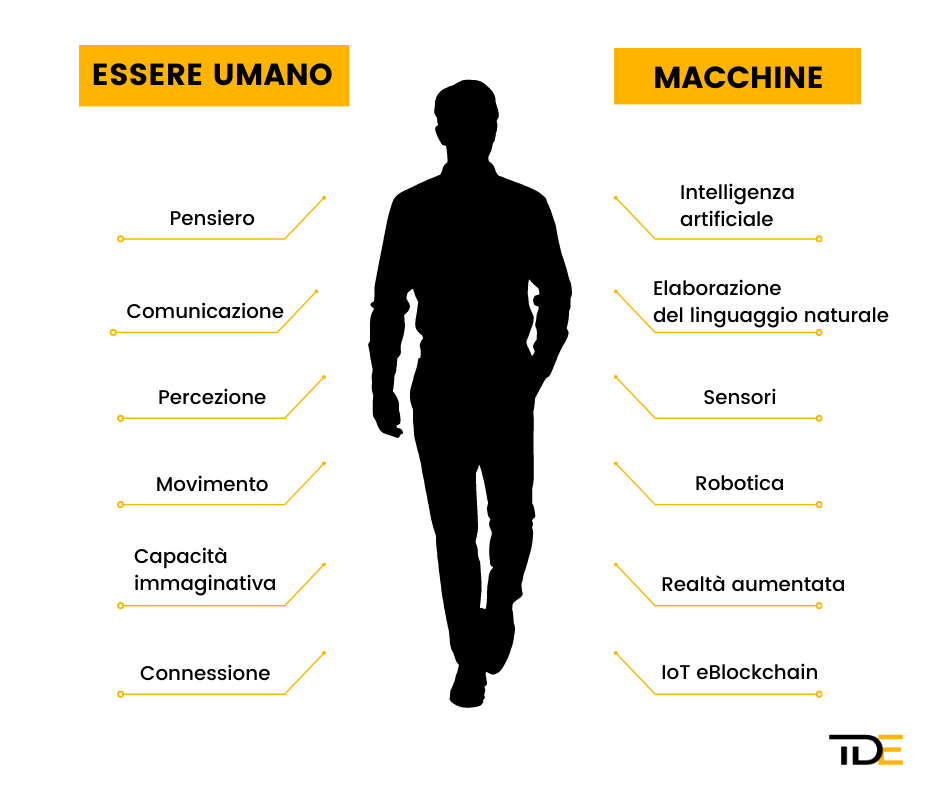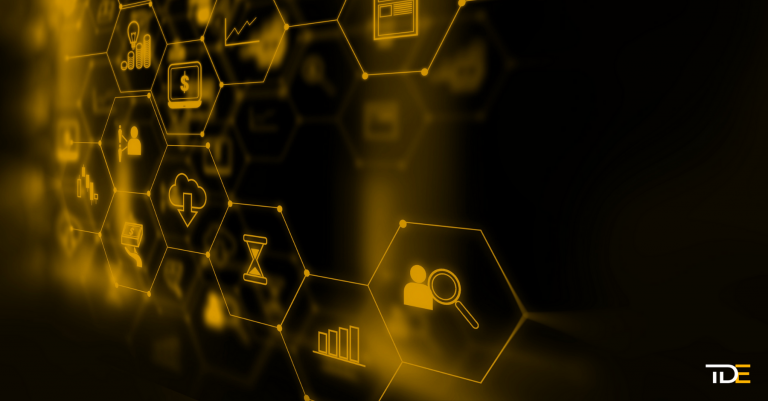Forse non lo sapevate ma la prima forma di intelligenza artificiale ha aiutato gli inglesi e gli alleati a vincere la seconda Guerra Mondiale.
si chiamava “British Bombe” e fu la macchina sviluppata e “addestrata” dal genio britannico della logica e della matematica Alan Turing e dal suo team di scienziati che permise di decifrare il linguaggio del codice che criptava le comunicazioni militari dei tedeschi.
I sottomarini tedeschi facevano affondare senza sosta i mezzi carichi d’armi e rifornimenti che viaggiavano dagli Stati Uniti alla Gran Bretagna attraverso il mare del Nord; per criptare i loro messaggi ricorrevano a una macchina chiamata “Enigma”, ma Bombe – la macchina di Turing – riuscì in una corsa contro il tempo a decifrare il codice permettendo così agli inglesi e agli alleati di anticipare i movimenti delle forze avversarie.
L’obiettivo più alto di Turing di creare una macchina capace di apprendere dall’esperienza ha praticamente aperto la strada al machine learning e conseguentemente all’AI.
Anche se sembra assurdo, le tecnologie avanzate sono state in gran parte inventate più di mezzo secolo fa: l’intelligenza artificiale, l’elaborazione del linguaggio naturale e la robotica programmabile, ad esempio, esistono dagli anni ‘50 del Novecento; le prime ricerche sul riconoscimento facciale sono iniziate negli anni ’60.
Ma allora vi chiederete perché si sono affermate solo negli ultimi anni?
Semplice: all’epoca le tecnologie non erano potenti come lo sono oggi e l’archiviazione dei dati era ancora parecchio impegnativa e costosa. E’ stata la maturità di sei fattori abilitanti che ha reso possibile l’ascesa di queste tecnologie:
1. potenza di calcolo
2. software open source
3. Internet ad alta velocità
4. cloud computing
5. dispositivi mobili
6. big data

Oggi le “tecnologie avanzate” si trovano in una situazione di “sonno”, ma i trend dicono che finalmente decolleranno nel prossimo decennio.
Le tecnologie avanzate imitano gli esseri umani
Quelle che vengono chiamate “tecnologie avanzate” in sostanza cercano di emulare e riprodurre il cosiddetto apprendimento contestualizzato proprio dell’essere umano: in quanto umani impariamo dall’esperienza, ovvero siamo in grado di comunicare, percepire e muoverci in base agli stimoli ambientali. In altre parole, acquisiamo conoscenze, selezioniamo elementi rilevanti in base alla nostra esperienza di vita e così sviluppiamo una visione complessiva del mondo.
Allo stesso modo, i motori di intelligenza artificiale non sono progettati per apprendere da soli, devono essere addestrati mediante algoritmi a capire cosa apprendere. Estraggono elementi rilevanti dai big data che fungono da esempi contestualizzati e infine possono “comprendere” gli algoritmi e capire il significato profondo dei dati.
Così i sensori ambientali imitano i cinque sensi umani (si pensi al riconoscimento facciale e dell’immagine che può aiutare le macchine a distinguere oggetti in base al modello di apprendimento visivo utilizzato dagli esseri umani); l’NLP – o l’elaborazione del linguaggio naturale – diventa “l’abilità cognitiva” dei computer; la robotica permette alle macchine di compiere movimenti fisici; la realtà aumentata e la realtà virtuale cercano di imitare la capacità immaginativa dell’uomo sovrapponendo due realtà diverse, fisica e digitale; IoT e blockchain infine riproducono il modo in cui le macchine dovrebbero “socializzare” e realizzano la connessione.

La bionica, ovvero la scienza che studia la struttura e le funzioni degli organismi viventi allo scopo di trarne elementi utili per realizzare apparecchiature tecnologiche, ci mostra che sono questi i sei modi in cui le tecnologie imitano gli esseri umani.
Esempi di tecnologie avanzate al servizio delle imprese
INTELLIGENZA ARTIFICIALE
L’AI è più popolare di quanto si possa immaginare.
Non è ancora quella tecnologia che vediamo nei film di fantascienza e che francamente fa a tutti un po’ di paura perché ha un livello di consapevolezza pari al livello umano. Questa forma di intelligenza artificiale che si chiama AGI – Artificial General Intelligence – non è ancora disponibile e la sua fase di sviluppo richiederà almeno altri 20 anni. L’intelligenza artificiale più comune, invece, quella “meno sofisticata” o ristretta (questo l’aggettivo corretto) è la forma di AI ampiamente utilizzata per automatizzare attività di routine in diversi settori. Le società di servizi finanziari la usano per automatizzare il rilevamento delle frodi fiscali; Google lo fa per consigliare le ricerche mentre digitiamo le singole lettere sulla barra di ricerca; Amazon la utilizza per fornire consigli utili sui libri, Uber per impostare prezzi dinamici e le compagnie aeree per gestire il servizio clienti tramite Chatbot.
Questo per dire che ogni tipo di processo ricorrente e standardizzato può utilizzare sistemi di automation e che l’intelligenza artificiale, in pratica, sostituisce e rende automatiche le più attività noiose e ripetitive, quelle che in genere provocano errori umani.
Un’altra cosa importante è che l’AI trasforma i dati non strutturati in informazioni strutturate. Cosa vuol dire?
Vediamo un paio di applicazioni. Nel campo del marketing, ad esempio, basandosi sui post pubblicati sui social media, sulla cronologia delle transazioni e su altri dati comportamentali, l’AI può raggruppare i clienti in cluster, consentendo alle imprese di effettuare segmentazione e targeting del mercato a partire dai dati. Quindi dall’interpretazione dei big data si traggono quelli che vengono chiamati insight. E che cos’è questo se non la base per le imprese di proporre customizzazione e personalizzazione nelle campagne di raccomandazione dei prodotti, nella determinazione dei prezzi e nel content marketing? Man mano che i clienti rispondono alle offerte così formulate, il computer continua ad apprendere e a modificare il proprio algoritmo.
Un altro esempio di integrazione di soluzioni di intelligenza artificiale nei processi aziendali diversi dal marketing potrebbe essere quello di Ant Financial che ha reinventato l’assicurazione auto utilizzando il riconoscimento delle immagini e del machine learning: i clienti possono presentare una richiesta di risarcimento di un sinistro sulla base di una foto fatta con il proprio smartphone; il motore AI analizza l’immagine e stabilisce se la richiesta è legittima.
In definitiva, potremmo dire che l’AI è il cervello dell’automazione e per offrire una customer expereince di ultima generazione deve essere associata ad altre tecnologie come robotica, riconoscimento facciale, tecnologia vocale, sensori. Non è più confinata nei laboratori di ricerca informatica e crea valore, ma certamente va gestita con attenzione.
ELABORAZIONE DEL LINGUAGGIO NATURALE NLP
Le macchine sono in grado di riprodurre il modo di comunicare umano, scritto e parlato ed è straordinario se pensiamo che nella sua forma naturale il linguaggio umano è spesso impreciso, involuto, ambiguo.
I chatbot sono certamente l’applicazione più diffusa dell’elaborazione del linguaggio naturale e con la tecnologia vocale le macchine sono migliorate molto anche nel rispondere ai comandi verbali. Ma non mi riferisco ai chatbot semplici, quelli che possono rispondere solo a domande chiuse, ma a quelli “potenti” basati appunto sul NLP. Sono i chatbot in grado di interpretare domande non standardizzate e dare una risposta, capaci di comprendere un messaggio in una chat anche se contiene rumore comunicativo come errori di digitazione, slang o abbreviazioni; quelli che sanno addirittura comprendere i sentimenti e rilevare, ad esempio, affermazioni sarcastiche.
In merito ai comandi verbali, sappiamo che sono ormai disponibili moltissimi assistenti vocali: Alexa di Amazon, Siri di Apple, Assistant di Google e Cortana di Microsoft. Queste applicazioni sono già pienamente capaci di rispondere a domande semplici e di eseguire comandi in più lingue, ma la demo di Google Duplex presentata all’I/O 2018 ha dimostrato qualcosa di straordinario: come un’assistente virtuale possa svolgere senza problemi conversazioni in linguaggio “super” naturale, direi. Quando si chiama un salone di parrucchiere o un ristorante per prenotare un appuntamento, l’assistente vocale abbandona il tono robotico e aggiunge persino l’uso di pause e di intercalari rendendo l’interazione più realistica che mai.
Le soluzioni tecnologiche che utilizzano l’NLP nella vendita, per esempio, spesso riducono la necessità di ricorrere a canali dai costi più elevati come i call center inbound e il telemarketing outbound. Imprese come Lyft, Sephosa e Starbucks utilizzano i chatbot per l’acquisizione degli ordini e le interazioni con i clienti, mentre in ambito B2B HubSpot e RapidMiner li usano per qualificare i lead e indirizzare i potenziali clienti ai canali di follow up più opportuni.
SENSORI
Oltre che dal riconoscimento del linguaggio scritto e parlato i computer apprendono anche dal riconoscimento di volti e immagini. Qual è il meccanismo di funzionamento?
Un’immagine vene scansionata e sostanzialmente vengono cercate somiglianze nel web o nel database. L’esempio più semplice è quello della ricerca per immagini di Google o Google lens – che consente di “cercare ciò che si vede” utilizzando una fotocamera o una foto, ma se pensiamo ai processi aziendali cosa possono fare i brand? Le aziende possono scansionare dai post sui social media le persone che acquistano e consumano i loro prodotti e inviare brevi messaggi di ringraziamento; o al contrario possono identificare le persone che utilizzano brand concorrenti e invitarle a cambiare; possono fare una comunicazione promozionale altamente mirata e aumentare così la propria quota di mercato. O ancora, le aziende possono fare come Tesco che nel Regno Unito prevede di installare alle casse una telecamera per il riconoscimento facciale al fine di identificare l’età degli acquirenti di alcolici e sigarette e di consentir e il pagamento automatizzato senza la presenza di un cassiere umano. Possono sfruttare il principio che sta alla base dei sistemi telematici installati nelle automobili che servono a migliorare la sicurezza e fornire assistenza nella gestione del veicolo.
Le aziende possono utilizzare i sensori per alimentare l’AI con la comprensione di tutto ciò che interessa loro approfondire.
ROBOTICA
Dagli anni ’60, le grandi imprese dei paesi industrializzati hanno utilizzato i robot principalmente per l’automazione back-end, in primis nella produzione – data la sua natura ad alta intensità di manodopera. Negli ultimi anni, invece i robot hanno addirittura sostituito gli esseri umani nelle interfacce rivolte ai consumatori tant’è che uno degli esperimenti più estremi di robotica si ha forse nel settore dell’ospitalità, dove il ruolo umano è fondamentale: in Virginia la catena alberghiera Hilton ha adottato in via sperimentale Connie, un robot concierge che consiglia agli ospiti attrazioni e ristoranti nelle vicinanze; l’Aloft Hotel di Cupertino ha introdotto un robot maggiordomo chiamato Botlr che propone servizi ed effettua il servizio in camera e lo Studio M Hotel di Singapore usa addirittura un robot chef per preparare le omlettes.
La robotica applicata all’ospitalità e all’assistenza vanno di pari passo: Toyota e Honda stanno investendo in carebot per l’assistenza agli anziani, il robot Pepper di Softbank diventa una persona di compagnia nelle case di cura e un assistente alle vendite nei negozi al dettaglio e Nestlé in Giappone utilizza robot per produrre, vendere e servire caffè.
Sebbene la pensiamo spesso in forma umanoide, la robotica non riguarda solo i robot fisici. Una tendenza in crescita è l’automazione robotica dei processi (RPA – Robotic Process Automation) che riguarda il software per la robotica. Si tratta di robot virtuali che eseguono lavori al computer sulla base di apposite guide come farebbe un essere umano. Le imprese lo utilizzano ad esempio per automatizzare fatturazioni e pagamenti, per la gestione delle risorse umane compresa l’elaborazione delle buste paga, nelle vendite per la gestione del CRM e nel marketing per la pubblicità programmatica – che implica offerte automatiche di acquisto di spazi pubblicitari digitali per ottimizzare i risultati.
L’RPA può essere utilizzata in diversi modi e il suo utilizzo sta diventando molto popolare anche a causa dell’aumento dei budget allocati sulla pubblicità online.
REALTA’ MISTA
Nel campo dell’innovazione delle interfacce utente tridimensionali, la realtà aumentata (AR) e quella virtuale (VR), insieme alla realtà mista (MR), spiccano tra le soluzioni più promettenti e rendono sfumati i confini tra il mondo fisico e quello digitale. Potremmo semplificare dicendo che l’AR è simile al portare oggetti digitali nel mondo reale, mentre la VR assomiglia al portare le persone nel mondo digitale; entrambe sono tipicamente associate al mondo dell’intrattenimento e del gaming perché le soluzioni attuali si concentrano principalmente in questi due ambiti, ma la capacità di operare nel mondo phygital tramite la MR è un punto di svolta anche nel marketing, soprattutto perché offre infinite possibilità di content marketing decisamente più coinvolgente.
Il settore turistico è quello che utilizza la MR per offrire virtual tour e incoraggiare le persone a visitare una destinazione del mondo fisico. Il Louvre, ad esempio offre un’esperienza virtuale agli utenti che indossano gli auricolari HTC Vive VR non solo per vedere da vicino la Gioconda, ma anche per accedere a narrazioni sul dipinto.
“
The VR
will help visitors
to understand what is behind the curtain
I rivenditori lo utilizzano per permettere ai clienti di “provare” o “consumare” virtualmente i prodotti prima di decidere di acquistarlo o per fornire tutorial. Ikea, per esempio, produce immagini 3D dei propri prodotti e utilizza l’AR per aiutare i potenziali acquirenti a visualizzare come un mobile si inserisca nelle loro case.
Nel settore automobilistico, poi, aziende come Ferrari prevedono Car Configurator che permettono agli utenti di scegliere colori, design, setup, ruote e customizzare la propria Ferrari in ogni dettaglio attraverso esperienze di configurazione interattiva 3D.
INTERNET OF THINGS (IoT) E BLOCKCHAIN
L’IoT si riferisce all’interconnettività di macchine e dispositivi che comunicano tra loro. Se gli individui possono utilizzare l’IoT per avere quelle che vengono chiamate “case intelligenti”, le imprese possono utilizzarla per il controllo da remoto, il monitoraggio di beni come edifici e veicoli della flotta aziendale e per offrire una customer experience senza soluzioni di continuità.
L’esempio più palese di una customer experience fluida è il MagicBand dei parchi Disney: il braccialetto comunica continuamente con migliaia di sensori collocati nelle varie attrazioni, nei ristoranti, nei negozi e negli hotel tramite una tecnologia a radiofrequenza, memorizza le informazioni sui visitatori e funziona quindi come a) biglietto per Disneyland b) chiave della stanza d’albergo e c) strumento di pagamento. In questo modo l’Internet of Things elimina tutti i punti di attrito dell’esperienza e nel contempo la migliora: permette ad esempio al personale di monitorare i movimenti dei clienti, anticipare l’arrivo degli ospiti in un raggio di 12 metri e servirli in modo proattivo.
La blockchain, invece, è conosciuta principalmente come la tecnologia che sta alla base dei bitcoin, ma ha un grado di applicabilità praticamente infinito. Si tratta di un sistema di registro aperto e distribuito, ovvero decentralizzato, che contiene dati crittografati attraverso una rete peer-to-peer. In poche parole un “blocco” della blockchain è come una pagina di libro mastro che contiene tutte le transazioni effettuate in precedenza. Una volta che un blocco è completato, non può più essere modificato e cede il passo al blocco successivo della catena di blocchi. Il punto di svolta della blockchain sta fondamentalmente nella natura sicura e trasparente della gestione e conservazione dei dati pertanto la tecnologia diventa garante di verità.
Permette ad esempio di registrare e tracciare intere filiere – pensate all’offerta di prodotti dichiarati 100% biologici garantita dalla registrazione delle transazioni lungo la supplay chain – e di condividere e gestire dati distribuiti dei clienti tra più imprese e brand. Tutto in nome della trasparenza.
SPUNTI DI RIFLESSIONE
Nella vostra azienda adottate tecnologie avanzate? Avete pensato alla road map tecnologica della vostra organizzazione nei prossimi cinque anni?
Se avete voglia di reinventare in vostro business sfruttando le opportunità offerte dalle tecnologie avanzate, non esitate a mettervi in contatto con il team TDE!
Siamo a vostra disposizione!
01/12/21
Oriana Torregrossa | Digital & Communication Manager TDE
Source: Marketing 5.0 – Philip Kotler
